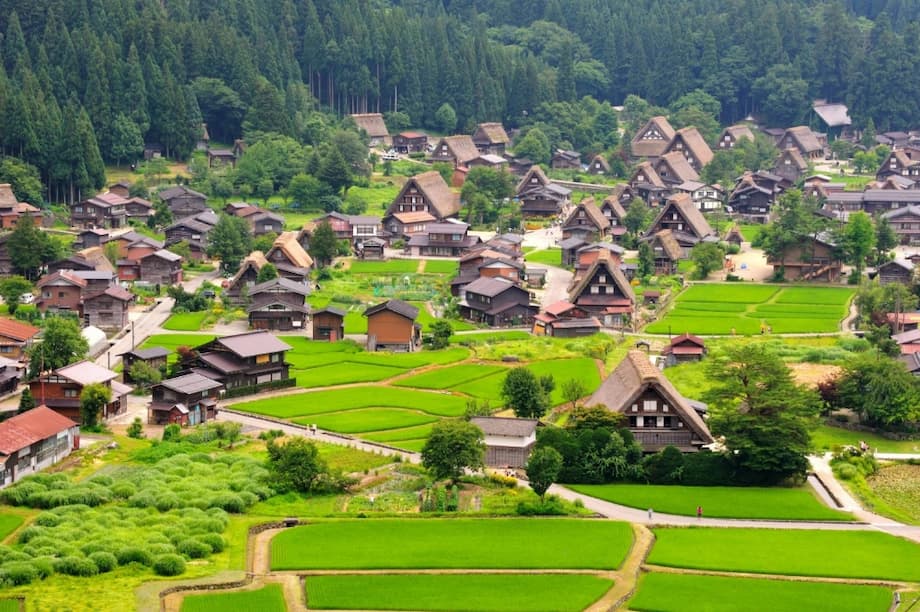A new global ranking crowns a quiet alpine treasure
Shirakawago, the thatched roof settlement tucked into the mountains of Gifu Prefecture, has been named the most beautiful village in Asia in a new global list of 50 villages curated with input from travel experts. It also places ninth worldwide. The recognition spotlights a place where steep thatch rises against forested slopes and where the daily rhythm still reflects a rural way of life. The accolade reinforces a reality that visitors sense as soon as they arrive. The village looks timeless, yet it remains lived in and carefully maintained by a small community.
The setting is part of the allure. Winters bring deep snow, and roofs designed like joined hands shed that weight with ease. The village lanes feel hushed at dusk, when wooden houses glow from within and smoke curls into the cold air. On select winter evenings, illumination nights cast a warm light over the snow, creating a scene that looks almost like starlight settled on rooftops. In other seasons, green rice fields, clear streams, and surrounding woods create a different kind of calm.
Shirakawago is recognized by UNESCO as part of the Historic Villages of Shirakawa go and Gokayama, an honor granted for the preservation of traditional architecture and a landscape shaped by centuries of adaptation to a harsh climate. The new ranking underscores that this is not only a beautiful place to photograph. It is a living cultural landscape where historic design still serves a practical purpose and where residents work with local and national authorities to keep the village intact for future generations.
What makes Shirakawago stand out in Asia?
The village’s beauty is inseparable from how people built homes and organized life in a remote alpine valley. Rather than replicating the past as a theme park, Shirakawago shows how traditional design evolved to meet real needs. The result is a form of architecture that looks dramatic and also works in one of Japan’s snowiest regions. The wider setting, from terraced paddies to shrines and waterways, completes a scene that many travelers associate with the heart of rural Japan.
Architecture with purpose: gassho zukuri
The trademark houses known as gassho zukuri use steep thatched roofs and massive timber frames to handle heavy snow and strong winds. The triangular profile is more than picturesque. It creates large attic spaces once used to raise silkworms, a vital household industry when the region was isolated and hard to reach. Thatching is a living skill here. Residents and craftspeople periodically rethatch using traditional techniques, a labor intensive process that helps bond the community and keeps the structures weather tight. Many houses employ wooden joinery with little visible metal, and interior spaces are flexible, with smoked beams and earthen floors that reflect rural life over centuries.
A landscape shaped by isolation
For a long time these villages were cut off by mountains and snow. That separation helped preserve the original layout of hamlets like Ogimachi in Shirakawago and Ainokura and Suganuma in nearby Gokayama. The alignment of homes, storehouses, paths, paddies, and waterways feels organic and deliberate. Today, strict protections as Important Preservation Districts limit alterations that could dilute that character. Fire remains a serious risk for thatched buildings, so the villages have extensive prevention systems and water resources in place. Those layers of management, from local to national level, allow daily life to continue while keeping the historic scenery intact.
A living community, not a museum
Shirakawago is a small community with working fields, shrines, and schools. Some families open historic homes as museums or operate simple guesthouses known as minshuku. Capacity is limited by design, and the village keeps late night noise low to preserve quiet for residents. Visitors who treat it as a neighborhood rather than a backdrop tend to enjoy their time more. Respecting private property, staying on marked lanes, and asking before taking close up photos of people are simple ways to honor the place.
How the global list is trending, and where Asia ranks
The new list places eight European villages in the top eight slots, a reminder of how strongly classic European scenery performs in beauty rankings. Yet Japan’s Shirakawago breaks that pattern at number nine, a clear nod to traditional Japanese design in a dramatic alpine setting. The companion entry from Asia in the top ten is Batad in the Philippines, where an amphitheater of rice terraces rivals any man made landscape for visual impact.
- 1. Bibury, England
- 2. Hallstatt, Austria
- 3. Reine, Norway
- 4. Giethoorn, Netherlands
- 5. Gasadalur, Faroe Islands
- 6. Oia, Greece
- 7. Bourtange, Netherlands
- 8. Kotor, Montenegro
- 9. Shirakawa go, Japan
- 10. Batad, Philippines
Asia features strongly across the full list of 50, with entries that span very different landscapes and cultures. Alongside Shirakawago and Batad are places like Hahoe Folk Village in South Korea, Ubud in Indonesia, Ghandruk in Nepal, Zhouzhuang in China, Ban Rak Thai in Thailand, Cam Thanh in Vietnam, Arang Kel in Pakistan, and Mrauk U in Myanmar. The breadth of locations underscores that beauty can mean snow on thatch, terraced hillsides, canal towns with stone bridges, and lakeside villages where tea and dusk share the same quiet tempo.
Experiencing Shirakawago through the seasons
Each season reshapes the village. Winter is the headline act. Snow piles high, and the steep roofs cope with the load as they were designed to do. On select weekends the village runs illumination nights, when warm light paints the snow and the mood turns almost theatrical. Crowds are carefully managed on those evenings, with access and parking controls to protect both scenery and safety. Weather can be severe, so winter travelers need proper footwear and warm layers.
Spring brings the first greens in the paddies and blossoms along the lanes. Summer is lush and vibrant, with streams running full and the surrounding forest at peak color. Autumn can be spectacular, as hills turn shades of copper and the slanting light at late afternoon makes the thatch glow. The same houses that shed winter snow look gentle under autumn leaves, and the village feels unhurried in the shoulder seasons.
For the postcard view of Ogimachi, follow the path or shuttle to the old castle observation point above the village. The panorama reveals the logic of the settlement, from house orientation to fields and river bends. At busy times, access may be timed or restricted to avoid gridlock, a reminder that good views also require careful stewardship.
Shirakawago is part of a trio. Nearby Suganuma and Ainokura in the Gokayama area share the same architectural tradition within a quieter setting. Many travelers combine all three. Ogimachi has the largest cluster of houses and more visitor services. Suganuma and Ainokura offer a more tranquil pace, especially early and late in the day, with photogenic scenes of houses, paddies, and stone lined lanes.
Preservation pressures and visitor etiquette
Global publicity draws more travelers, which brings benefits and stresses. The village receives heavy day trip traffic from hubs like Takayama, Kanazawa, and Toyama. Facilities are modest by design. Litter bins are limited and entry to the historic area is not gated. During peak times, parking and foot traffic can feel intense. Local managers have occasionally closed or adjusted access to popular vantage points to keep the experience safe and orderly. For a small rural community, the difference between a respectful visitor and a careless one is significant.
The UNESCO World Heritage Centre describes exactly why these villages matter, focusing on the way people and place fit together. It also emphasizes the need for careful maintenance.
The historic villages are exceptional examples of traditional human settlements perfectly adapted to their environment and social needs, preserving both spiritual and material evidence of their history.
Fire risk shapes many rules, from smoking restrictions to the use of designated smoking areas. Thatched roofs are vulnerable to sparks and embers, which is why sprinklers and hydrants are found throughout the village and why coordinated thatch maintenance remains vital. The buildings are protected under Japanese law with strict regulations on alteration and demolition. That legal framework supports local choices about how to welcome visitors without eroding the traditional character that draws people in the first place.
How to visit responsibly
- Use public transport when possible. Buses from Takayama, Kanazawa, and Toyama reduce traffic in the village.
- Stay overnight if you can. A night in a farmhouse spreads spending and eases daytime congestion.
- Carry your trash until you find a bin. Do not leave items in toilets, ditches, or snowbanks.
- Keep to marked paths and respect private homes and fields. Many houses are lived in.
- Be quiet after dusk. Sound carries in the valley and the community values calm evenings.
- Do not fly drones without permission. Safety and privacy rules are enforced.
- Support local culture by visiting house museums and buying local crafts like silk items or regional snacks.
- Check official updates on illumination events, road conditions, and parking before you go.
Economic stakes for rural Japan
Honors like this one bring attention and income to regions that face aging populations and shrinking households. Tourism revenue supports roof maintenance, cultural activities, and the small businesses that keep villages lively. At the same time, leaders in preservation districts across Japan stress that popularity cannot come at the cost of authenticity. Limits on building changes, signage, and traffic are part of that balance. Visitors who plan carefully and spread out across seasons help sustain the rural economy while reducing strain during a few crowded weekends each year.
The preservation model here relies on cooperation. Residents, local associations, prefectural offices, and national agencies share responsibility for firefighting, thatch work, and repair. Training the next generation of thatchers and carpenters is as important as selling tickets to a house museum. The new ranking will likely boost interest, which makes that pipeline of skills and the community’s own decision making doubly important.
Planning essentials
Most visitors reach Shirakawago by bus. The village sits between Takayama in Gifu, Kanazawa in Ishikawa, and Toyama on the Sea of Japan coast, with direct services from all three. Driving is possible when roads are clear, but winter conditions and limited parking make public transport a smart choice. Wear sturdy shoes. Lanes are often wet or icy, and you will want to walk to viewpoints and across the suspension bridge over the river for the classic approach to Ogimachi.
Overnight stays in traditional houses book up months in advance. English language booking can be limited for some minshuku, so flexibility helps. If you cannot stay in the village, consider a night in Takayama, Kanazawa, or Toyama, then visit early in the morning or later in the afternoon for fewer crowds and warmer light. Winter illumination dates are fixed and controlled for safety. Check schedules long before you travel.
Historic homes like Wada, Kanda, and Nagase open parts of their interiors as small museums with family artifacts and information on how the architecture works. Myozen ji Temple, the village shrine, and the narrow main street with its shops and snack stalls give a sense of daily rhythm. Try regional dishes like Hida beef, gohei mochi rice cakes brushed with sweet miso, and mountain vegetable plates. For official background on the World Heritage status, consult the UNESCO listing for the Historic Villages of Shirakawa go and Gokayama at the World Heritage Centre.
Key Points
- Shirakawago was named the most beautiful village in Asia and ninth worldwide in a new list of 50 villages.
- The village is a UNESCO World Heritage site, recognized for gassho zukuri houses and a landscape adapted to heavy snow.
- Europe took the top eight places on the global list, with Asia well represented across the full top 50.
- Winter illumination nights, deep snow, and steep thatched roofs define the village’s most iconic season.
- Strict preservation rules, fire prevention systems, and community maintenance keep the historic fabric intact.
- Visitor etiquette is essential, including carrying trash, respecting private homes and fields, and keeping noise low after dusk.
- Staying overnight, using buses, and spreading visits beyond peak events help the local economy and reduce pressure.
- Nearby Suganuma and Ainokura offer quieter experiences within the same World Heritage landscape.




